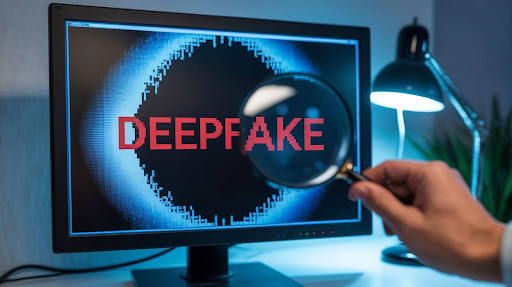Over the last few years, artificial intelligence has developed at a blistering rate, taking over industries, changing the way people communicate, and redefining how people produce and consume online content. One of the most interesting and, at the same time, the most worrying consequences of such development is the development of deepfake applications. They use more advanced AI models to manipulate or create high-realism videos, pictures, or audio that can be close to real media. At the same time as deepfake technology offers an opportunity to be creative, humorous, and even educational, but it can also threaten privacy, trust, and security, so deepfake detection technology is a critical research and development area.
What Are Deepfake Apps?
Deepfake applications are machine learning programs or tools, specifically deep neural networks. Visual or audio data in large volumes are studied by these systems and the patterns are subsequently learnt, which can be used later to replace, edit, or imitate the likeness or voice of a person. As an illustration, a deepfake application could produce a video in which one individual seems to be talking or acting in a way they have never done, and it can be astonishingly realistic. Deepfake is also referred to as such due to its name, which is based on the deep learning AI-based technique, and faked, emphasizing the fact that it is fake. Compared to the older techniques of digital editing, which used to need both specialized expertise and costly software, deepfake applications have turned this procedure into something that can be performed by ordinary people. This availability has been a source of their fame and quick dissemination throughout the social media and online communities.
The Positive Potential of Deepfake Apps
Even though deepfakes are perceived to be connected with deception, there are also positive examples of how the tools can be applied:
Entertainment and Creativity Content creators, filmmakers, digital artists explore deepfake apps to create new visual effects or recast characters in a different manner.
- Education and Training – Deepfake-based simulations can be used in classrooms and during professional training to simulate historical events or make realistic language-learning avatars or to create simulated role-play scenarios.
- Accessibility – Voice and facial synthesis through Deepfake can offer more methods through which people with disabilities can communicate, such as generating speech on behalf of individuals who lost their voices.
These affirmative uses prove that the technology of deepfakes itself is not necessarily bad- how the technology is used characterizes its effect.
The Risks and Concerns
The deepfake apps, in spite of their potential, have become a source of concern across the world because of their misuse. The risks that include some of the major ones are:
- Misinformation and Fake News: Deepfakes may cause disinformation to disseminate, by creating the illusion that high-profile individuals have said or done something they have never said or done.
- Fraud and Identity Theft: Deepfakes can help criminals scam people under the guise of an identity, attempt to lure companies to transfer money or to gain access to personal accounts.
- Privacy Violations: Images or video of a person may be manipulated with no permission, which contributes to the reputational damage or harassment.
- Loss of Trust: With more and more convincing deepfake applications, the idea of trusting online content is eroded, and the world turns into a place where seeing is not believing anymore.
Such dangers explain why the need to detect deepfakes has been such a pressing issue.
Deepfake Detection Technology
Developments in deepfakes are matched by those in technology to detect them. The technology of deepfake detection is a union of computer vision, machine learning, and forensic examination to identify authentic content and controlled media. Researchers and organisations are developing a number of solutions:
- Biometric Inconsistencies – Detection devices can examine movements in the face, the blinking motions of the eye, or a micro-expression, which are not necessarily part of the natural human behavior.
- Pixel and Audio Analysis – Detection systems can detect a discrepancy or irregularity that has been left behind in the deep fake generation process by studying the video frames or sound waves.
- Metadata Analysis – Digital files that are authentic have special metadata. File detection can check file characteristics in order to find evidence of interference.
- AI-Powered Counter-Models – The same way that deepfake apps are AI-based applications, which utilize neural networks to create fake media, other AI models are being trained to detect those fakes in real time.
Quick evolution of detection systems is paramount, because the ill intent of deepfakes may compromise elections, business security, and even national security.
Striking a balance between Innovation and Responsibility.
The gluttony of deepfake apps has become the subject of a significant discussion: how to allow the creative capabilities of this technology to work in society, and reduce its harms at the same time? A number of strategies can be used to achieve this balance:
- Awareness and Education – Educating individuals about the nature of deepfakes, how to be more suspicious of the information they encounter can act as a means to make people more critical information consumers.
- Regulation and Policy– Governments and other regulatory bodies are investigating new system to establish ethical use of synthetic media and put in place consequences of harmful misuse.
- Convergence in Sectors – Technology firms, researchers, and cybersecurity experts are also collaborating to enhance deepfakes detection technology and ensure that the tools are accessible to as many as possible.
- Ethical Innovation – The creators of deepfake apps can create protective features, like watermarks or identifiers that can be detected, to differentiate between synthetic and authentic material.
Looking Ahead
A good illustration of how AI is changing the online world is in deep fake applications. They represent the possibilities of creativeness of the modern technology, as well as its moral issues. On the one hand, they facilitate the emergence of new narrative and communication possibilities; on the other hand, they undermined the established beliefs about the reality and veracity in the digital world.
The future of deepfake examples will majorly rely on the equilibrium of innovation and responsibility. It can be concluded that through robust investment in the technology of deepfake detection, awareness campaigns, and ethical standards in AI development, it is possible to use the benefits of deepfakes and reduce their dangers.
The answer to this question is that in the end it will be the reaction of society to deepfake apps that will determine the extent to which the digital age will allow us to trust it. With equal measures of innovation and care, we can come out of this new age of artificial intelligence with such tools with great creativity and with great caution.


